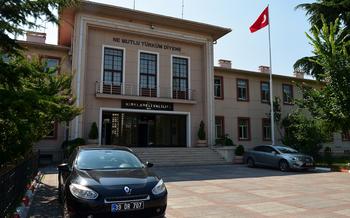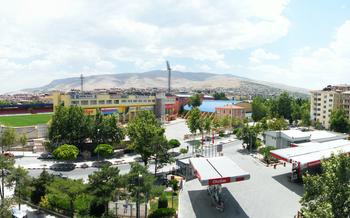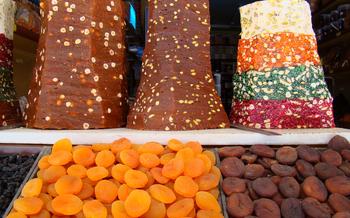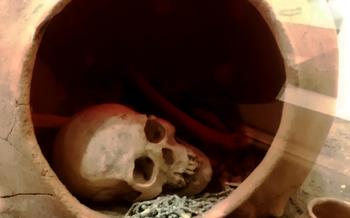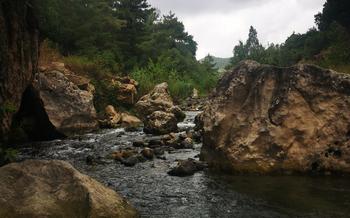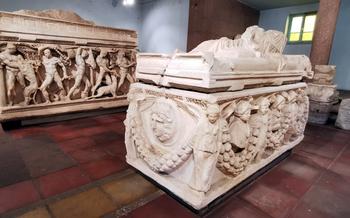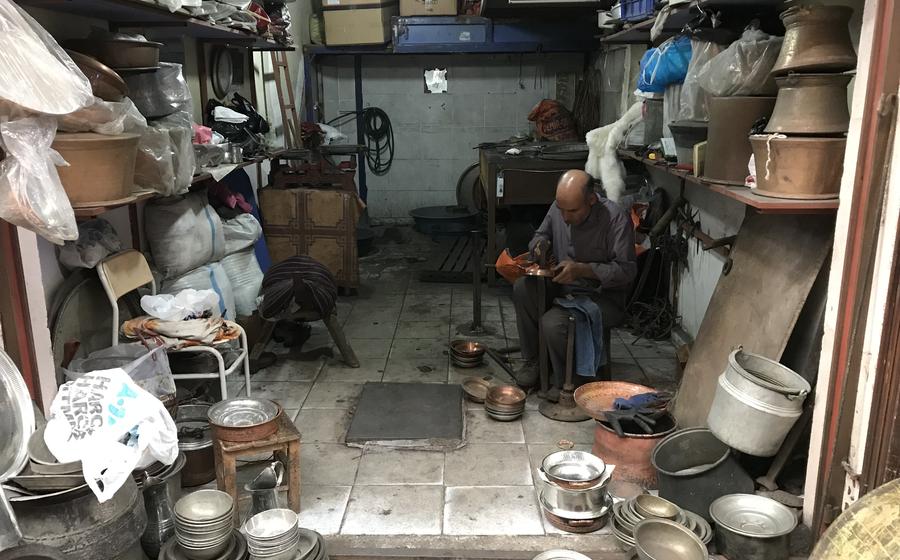
Melid (Ancient city near Malatya)
- A Journey to the Past: Unveiling the Ancient City of Melid
- Melid Through the Ages: A Historical Perspective
- Exploring the Ruins of Melid: A Walk Through History
- Melid's Enduring Legacy: The Armenian Heritage
- The Art of Mosaics in Melid: A Visual Feast
- The Melid Museum: A Treasure Trove of History
- Armenian Cuisine: A Culinary Journey
- Cultural Festivals and Events: Celebrating Melid's Heritage
- Armenian Churches and Monasteries: Sacred Spaces
- Hiking and Nature Trails: Exploring the Surroundings
- Local Crafts and Handicrafts: Preserving Traditions
- Melid in Literature and Art: Creative Expressions
- Respecting Local Customs and Traditions: A Cultural Exchange
- Safety and Security: Ensuring a Smooth Journey
A Journey to the Past: Unveiling the Ancient City of Melid
Melid, also known as Malatya, stands as a testament to the rich tapestry of history that Anatolia has witnessed. Once the capital of the Armenian kingdom of Commagene, Melid's roots trace back to the 2nd century BC when it served as a significant center of Armenian culture, politics, and trade. Situated in the heart of modern-day Turkey, approximately 650 kilometers southeast of Ankara, Melid invites travelers to delve into its ancient past and discover a realm where Armenian and Anatolian influences converge to create a unique cultural heritage.
The city's strategic location at the crossroads of major trade routes contributed to its prosperity and prominence. Accessible by road, Melid can be reached by car or bus from major Turkish cities. As you approach this ancient gem, a sense of anticipation builds, promising an encounter with the remnants of a civilization that once flourished in this region.
Unearthing the ruins and artifacts of Melid is like embarking on an archaeological adventure. The city's fortifications, temples, and residential areas beckon you to step back in time and witness the grandeur of a bygone era. As you explore the ancient ruins, each stone whispers tales of the Armenian kingdom's legacy and the diverse cultural influences that shaped its history.
Melid Through the Ages: A Historical Perspective
Melid's rich history spans millennia, leaving behind a tapestry of archaeological discoveries that reveal the city's evolution from an ancient Armenian kingdom to a thriving center under Roman and Byzantine rule. Excavations have unearthed layers of history, including the foundations of a grand Armenian fortress, intricate mosaic floors, and remnants of ancient temples and public buildings.
During the Armenian period, Melid flourished as a significant cultural and religious center. The city's Armenian roots are evident in the numerous churches and monasteries that dot the landscape, each a testament to the vibrant Armenian heritage that once thrived here. These sacred spaces, with their distinctive architecture and intricate frescoes, offer a glimpse into the deep-rooted Armenian influence that shaped the city's identity.
As the Roman Empire expanded its reach, Melid came under its influence, leaving behind a legacy of impressive infrastructure and urban planning. The Romans constructed aqueducts, roads, and public buildings, transforming Melid into a thriving provincial center.
Later, during the Byzantine era, Melid continued to prosper, with the construction of magnificent churches and the introduction of new architectural styles. The city's strategic location along trade routes contributed to its economic growth, attracting merchants and travelers from across the region.
The Ottoman conquest of the region in the 16th century marked a new chapter in Melid's history. Ottoman rule brought with it a blend of Islamic and Armenian influences, visible in the city's architecture and cultural practices. While the Armenian community faced challenges under Ottoman rule, they managed to preserve their cultural identity and religious traditions, contributing to the city's rich cultural heritage.
Exploring the Ruins of Melid: A Walk Through History
Melid's ruins stand as a testament to its rich history and architectural prowess. Explore the city's defensive structures, including the remnants of its sturdy city walls and imposing gates, which once protected its inhabitants from invaders. Discover the public buildings and temples, marveling at their intricate designs and grand scale, which hint at the city's former civic and religious life. Delve into the residential areas and houses, where the remains of homes and neighborhoods provide a glimpse into the daily lives of Melid's ancient residents. Unravel the ingenuity of ancient engineering as you trace the water systems and infrastructure, which ensured a steady supply of water to the city's population. Each step through these ruins invites you on a journey back in time, whispering tales of Melid's glorious past.
Melid's Enduring Legacy: The Armenian Heritage
Melid stands as a testament to the enduring legacy of the Armenian people, whose presence in the region dates back to ancient times. The city is home to numerous Armenian churches and monasteries, each with its own unique architectural style and historical significance. These sacred spaces showcase intricate artwork, religious symbolism, and centuries-old traditions that have been passed down through generations. Visitors can explore the stunning Armenian churches of Surp Asdvadzadzin, Surp Kevork, and Surp Sarkis, which feature beautiful frescoes, intricate carvings, and awe-inspiring domes. These churches serve as living reminders of the rich Armenian heritage that continues to thrive in Melid.
Moreover, Melid is home to a significant collection of Armenian inscriptions and artifacts that provide valuable insights into the language, culture, and history of the Armenian people. Ancient manuscripts, stone carvings, and pottery fragments have been discovered in the region, offering glimpses into the lives and beliefs of the Armenians who once called Melid home. Visitors can explore the Melid Museum to learn more about these fascinating artifacts and gain a deeper understanding of the Armenian heritage that permeates the city.
The Armenian Genocide, a tragic event in the history of the Armenian people, left an indelible mark on Melid. In remembrance of the victims of this horrific atrocity, a memorial has been erected in the city, serving as a poignant reminder of the resilience and perseverance of the Armenian spirit. Visitors can pay their respects and learn about the history of the Armenian Genocide at this memorial, honoring the memory of those who lost their lives.
The continuity of Armenian traditions, customs, and language in the region is a testament to the enduring legacy of the Armenian people in Melid. Traditional Armenian dishes, such as dolma, kufta, and lahmacun, are still prepared and enjoyed by locals, preserving the culinary heritage of the region. Armenian music and dance remain vibrant expressions of cultural identity, showcasing the rich artistic traditions of the Armenian people. Visitors can experience the warmth and hospitality of the Armenian community by participating in local festivals, attending cultural events, and engaging with the friendly locals who are proud to share their heritage with the world.
The Art of Mosaics in Melid: A Visual Feast
Melid is renowned for its exquisite mosaic floors, which adorn the ancient buildings and provide a glimpse into the artistic and cultural heritage of the region. These intricate artworks, crafted by skilled artisans, feature a diverse range of motifs, symbols, and iconography that narrate stories from mythology, religion, and daily life.
The mosaics in Melid are particularly notable for their vibrant colors and attention to detail. They depict scenes of hunting, feasting, religious ceremonies, and mythical creatures, offering a glimpse into the beliefs and values of the ancient inhabitants. The symbolism and iconography employed in the mosaics are rich and varied, providing valuable insights into the cultural and religious influences that shaped Melid's history.
Exploring the mosaic floors of Melid is a journey through time, allowing visitors to connect with the past and appreciate the artistic prowess of ancient artisans. Conservation efforts are underway to preserve and restore these fragile works of art, ensuring that they continue to inspire and captivate generations to come.
The Melid Museum: A Treasure Trove of History
Nestled in the heart of Melid, the Melid Museum stands as a testament to the region's rich history and cultural heritage. Within its walls, visitors embark on a journey through time, exploring a diverse collection of artifacts, exhibits, and archaeological discoveries that unravel the captivating story of Melid and its people.
The museum's galleries showcase a treasure trove of ancient inscriptions and texts, providing valuable insights into the languages and writing systems that once flourished in this ancient land. Visitors can decipher enigmatic scripts, marvel at beautifully preserved manuscripts, and uncover the secrets of forgotten civilizations.
Among the museum's highlights are the latest archaeological discoveries from the ongoing excavations at the Melid site. These remarkable finds, displayed with meticulous care, offer a tangible connection to the past, allowing visitors to witness firsthand the evolution of this ancient city.
The Melid Museum also hosts educational programs and workshops that promote the understanding and appreciation of Melid's heritage. These interactive sessions provide a platform for visitors to engage with experts, learn about the latest research, and delve deeper into the fascinating history of this remarkable region.
Whether you're a history buff, an archaeology enthusiast, or simply curious about the rich cultural tapestry of Melid, the Melid Museum is an essential destination. Its collection of artifacts, exhibits, and educational programs offers a captivating glimpse into the past, ensuring that the legacy of this ancient city continues to inspire and captivate visitors for generations to come.
Armenian Cuisine: A Culinary Journey
Armenian cuisine, a delightful blend of flavors, aromas, and traditions, is an integral part of Melid's cultural heritage. Savor the unique taste of traditional Armenian dishes that have been passed down through generations, reflecting the region's rich history and cultural influences. Discover the local ingredients and flavors that define the region's cuisine, creating a culinary experience that is both authentic and unforgettable.
Explore local restaurants and eateries that offer a warm and inviting atmosphere, allowing you to immerse yourself in the local culinary scene. Participate in cooking classes or workshops to learn the art of preparing Armenian dishes, gaining insights into the techniques and traditions that make this cuisine so special. Indulge in the vibrant flavors of traditional dishes such as khorovats (grilled meats), dolma (stuffed vine leaves or vegetables), and lahmacun (Turkish pizza).
Armenian cuisine is not just about food; it's a celebration of culture, community, and history. Each dish tells a story, connecting you to the Armenian heritage and the people who have lovingly crafted these culinary delights. Embark on a culinary journey in Melid, where every bite is an explosion of flavors and a testament to the region's rich cultural tapestry.
Cultural Festivals and Events: Celebrating Melid's Heritage
Melid's rich heritage is celebrated through a vibrant array of cultural festivals and events that showcase the region's unique Armenian identity. The annual Melid Festival is a highlight, attracting visitors from near and far to experience the vibrant spirit of the Armenian culture. This festival bursts with music, dance, art, and traditional crafts, providing an immersive experience into the region's rich history and traditions.
Participating in commemorative events that honor the history and legacy of the Armenian people is a profound way to connect with the region's past. These events pay tribute to the Armenian Genocide, remembering and acknowledging the struggles and resilience of the Armenian community. Understanding the significance of these events deepens one's appreciation for the Armenian heritage and its enduring spirit.
Discovering local traditions and customs that are still practiced in the region offers a glimpse into the living heritage of Melid. From traditional dances and music to unique culinary practices, these customs provide a tangible connection to the past. Exploring local markets and fairs that showcase traditional Armenian handicrafts, textiles, and souvenirs is an excellent way to support local artisans and take home a piece of Melid's cultural heritage.
Armenian Churches and Monasteries: Sacred Spaces
Melid is home to a wealth of ancient churches and monasteries, each with its own unique architectural style and historical significance. These sacred spaces stand as testaments to the deep-rooted Armenian Christian faith that has thrived in the region for centuries. Visitors can explore the intricately carved facades, admire the stunning murals and frescoes that adorn the interiors, and discover the religious artifacts and relics that hold spiritual and historical value for the Armenian community. Many of these churches and monasteries are still active places of worship, offering a glimpse into the vibrant religious traditions of the Armenian people. Some of the most notable churches include the Holy Mother of God Church, the Saint Gregory the Illuminator Church, and the Surp Stepanos Monastery, each with its own unique story to tell. These sacred spaces invite visitors to step back in time, immerse themselves in the rich history of Armenian Christianity, and experience the spiritual essence of Melid.
Hiking and Nature Trails: Exploring the Surroundings
Picturesque landscapes:
Embrace the breathtaking natural beauty of the region through hiking trails that wind through lush forests, rolling hills, and tranquil rivers. The Taurus Mountains, with their majestic peaks, offer a stunning backdrop to your journey.
Birdwatching and wildlife spotting:
Discover the diverse birdlife and wildlife that inhabit the area, providing opportunities for nature enthusiasts. Spot soaring eagles, colorful songbirds, and elusive mammals as you explore the region's rich biodiversity.
Panoramic views:
Hike to vantage points that offer panoramic views of the surrounding countryside, including the distant peaks of the Taurus Mountains. Take in the breathtaking vistas and capture the essence of Melid's natural splendor.
Local flora and fauna:
Learn about the unique flora and fauna of the region, including endemic plant species and rare wildlife. Discover the delicate wildflowers, towering trees, and fascinating creatures that call Melid their home.
Local Crafts and Handicrafts: Preserving Traditions
Melid is renowned for its thriving tradition of local crafts and handicrafts, which have been passed down through generations and play a vital role in preserving the region's cultural identity. Visitors can explore the bustling workshops of skilled artisans, where they can witness firsthand the creation of intricate carpets, delicate pottery, and finely crafted metalwork. These artisans employ traditional techniques and designs, ensuring the continuity of their ancestral heritage.
Shopping for souvenirs in Melid is a delightful experience, as visitors can discover unique handmade items that showcase the region's artistic flair. From intricately woven carpets and colorful ceramics to ornate jewelry and decorative metalwork, there is something to suit every taste and budget. By supporting local artisans, visitors not only acquire beautiful souvenirs but also contribute to the preservation of traditional crafts in the face of globalization.
Melid in Literature and Art: Creative Expressions
Melid's rich history and cultural heritage have inspired numerous literary and artistic creations. Local authors and poets have penned captivating stories and verses that delve into the region's past, its people, and their experiences. Their works offer unique perspectives and insights into the Armenian identity and the spirit of Melid.
Beyond literature, Melid's essence has been captured in various artistic forms. Local and international artists have found inspiration in the region's landscapes, architecture, and people, creating stunning paintings, sculptures, and photographs that showcase Melid's beauty and heritage. These artistic representations not only document the region's history but also serve as a bridge for cultural exchange, fostering a deeper appreciation for Melid's diverse artistic traditions.
By exploring the literary and artistic expressions inspired by Melid, visitors can gain a deeper understanding of the region's cultural tapestry. These creative works provide a unique lens through which to experience Melid, offering a glimpse into its soul and the stories that have shaped its identity over the centuries.
Respecting Local Customs and Traditions: A Cultural Exchange
When visiting Melid, it is crucial to prioritize cultural sensitivity and respect for local customs and traditions. Understanding and embracing the local culture enhances your experience and fosters meaningful interactions with the community. Dress appropriately, adhering to local norms and customs, to show respect and avoid causing offense. Engage in respectful and meaningful conversations with locals, asking questions and listening attentively to their stories and perspectives. Supporting local businesses and initiatives that contribute to preserving Melid's cultural heritage not only supports the community but also ensures the continuation of traditional practices. By respecting local customs and traditions, travelers can contribute to preserving the unique identity and heritage of Melid while creating a positive and enriching cultural exchange.
Safety and Security: Ensuring a Smooth Journey
Ensuring a safe and secure journey is of paramount importance when exploring any new destination. Melid is generally a safe place to visit, but it's always advisable to exercise caution and be aware of your surroundings. Familiarize yourself with local laws and regulations to avoid any misunderstandings or legal issues. Keep valuable items secure and avoid displaying them in public. In case of an emergency, essential contact information for medical assistance, law enforcement, and tourist support services should be readily available. Travel insurance is highly recommended to protect against unexpected events or emergencies.


